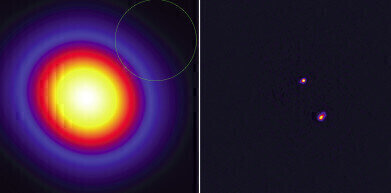-
 View of the LOFAR site at STFC Chilbolton Observatory, with the antennas belonging to the Low Band Array (LBA) in the foreground.
View of the LOFAR site at STFC Chilbolton Observatory, with the antennas belonging to the Low Band Array (LBA) in the foreground. -
 Credit: ASTRON and LOFAR commissioning teams led by Olaf Wucknitz (Bonn) and Reinout van Weeren (Leiden Observatory).
Credit: ASTRON and LOFAR commissioning teams led by Olaf Wucknitz (Bonn) and Reinout van Weeren (Leiden Observatory).
News
Giant Radio Telescope goes Multi-National
May 23 2011
A new UK telescope linked up to a network of others across Europe has delivered its first ‘radio pictures’of the 3C196 quasar (a black hole in a distant galaxy). The pictures were taken by the International LOFAR (Low Frequency Array) Telescope designed to study the sky at the lowest radio frequencies accessible from the surface of the Earth and co-ordinated by ASTRON in the Netherlands.
STFC’s Chilbolton Observatory in Hampshire, is the western most telescope station in LOFAR, which collectively is almost 1000 km wide and the largest telescope in the world. “This is a very significant event for the LOFAR project and a great demonstration of what the UK is contributing,” said Derek McKay-Bukowski, STFC/SEPnet Project Manager at LOFAR Chilbolton. “The new images are three times sharper than has been previously possible with LOFAR. “This is fantastic”, said Professor Rob Fender, LOFAR-UK Leader from the University of Southampton. “For the first time, the signals from LOFAR radio telescopes in the Netherlands, France, Germany and the United Kingdom have been successfully combined in the LOFAR BlueGene/P supercomputer in the Netherlands.” Requiring internet speeds of 10 gigabits per second getting that connection working without a hitch was a great feat requiring close collaboration between STFC, industry, UK universities and international partners,Professor Fender added.
A close up of the quasar 3C196. Both images show the exact same patch of sky around the quasar. On the left is the image taken by the Dutch LOFAR telescopes; the image on the right was taken by the combined multi-national LOFAR telescopes which together provide a resolution as fine as 0.2 arcseconds, close to 1/10000 of the diameter of the moon. The two bright spots show the locations where two jets from the massive black hole in the centre of the galaxy are hitting other material in the galaxy which hosts the quasar’.
Digital Edition
Lab Asia Dec 2025
December 2025
Chromatography Articles- Cutting-edge sample preparation tools help laboratories to stay ahead of the curveMass Spectrometry & Spectroscopy Articles- Unlocking the complexity of metabolomics: Pushi...
View all digital editions
Events
Jan 21 2026 Tokyo, Japan
Jan 28 2026 Tokyo, Japan
Jan 29 2026 New Delhi, India
Feb 07 2026 Boston, MA, USA
Asia Pharma Expo/Asia Lab Expo
Feb 12 2026 Dhaka, Bangladesh


















